Lower back pain impacts the ability to do exercise by 38% of the global population, and only 48% of people seek physical therapy, as oppose to:

- 54% chiropractic treatment
- 58% prescription medication drugs

The number 48 is just ringing in my ears, like WOAHH. That’s MASSIVELY small. How is it not enough?
Physical therapy is a great place to start. A physician can assess the type of exercise program you need tailored to your needs,so you don’t have to shoot for the stars blindly.
You shouldn’t mistaken the power of exercise. A good routine provides you:
- More nutrition to your muscles and tissue
- strengthens muscles and joints
- Gives you flexibility
- More mobility
- Lose weight
- Correct your posture
- Mental strength

and many more!
In this article I will be “pulling back the curtain” and showing you how to exercise with lower back pain, and what can be the best exercises you can get out of for your type of pain.
You may or may not have a routine put together, but no need to worry, I’ll show you the way to the “promise land” of exercises. The ones that are:
- The Do’s and Don’t
- Low impact activities
- Light stretching
- Exercise therapy
- weight strengthening
But before you get to reading, if you have lower back pain and sciatica both together, you’ll want an extensive look about exercising with both conditions. You can find that in the exercises for both LBP and Sciatica right here.
All For One, One For All?
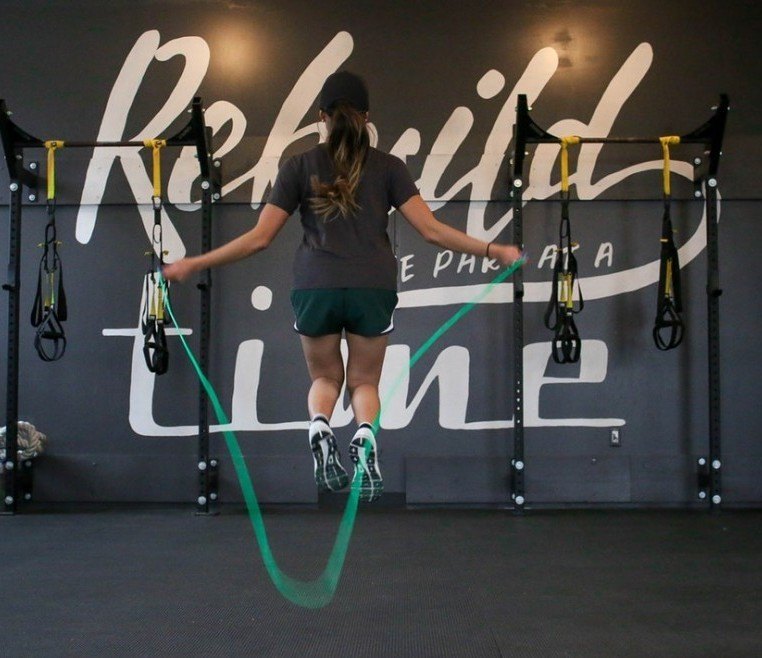
Are you building?… Or at least hoping to rebuild your way back to full activity? I want you to focus on yourself, one moment at a time, and one task at a time, and one breathe at a time. There are many people like your physical therapist that can point you in the right direction, so what makes my article any different? I’ve been in your shoes, and I’ve also recovered, thanks to my PT but also on my own time.
Doing things on your time will prove to be the LARGEST test, and that is because:
- we can’t always afford to pay for PT
- we spend more times with ourselves
- it promotes a faster healing process
Have you asked yourself if you were ever exercising the right way? If you have acute lower back pain, the chances are very slim, and if you have chronic lower back pain, surprisingly the same chances are accredited. Why?
For people with acute pain, it’s common to continue with regular activity until the pain persist, then stop. And what they do is rest which is their first mistake, and when they feel better, they go back to the same activity that got their back aches in the first place. Chronic pain acts similar…
Patients understand that they need rest, but they don’t understand that their pain needs more constant immediate attention. It’s imperative to educate yourself on what to do and not to do, so you don’t:
- stretch the wrong ways
- exercise the wrong ways
- strain your back
- cause further spinal pain
With any back pain symptoms, whether it be actue, sub-acute, chronic, or sciatic pain, it’s important to get moving the RIGHT WAY.
The Don’ts:
1.Don’t Lie Around
A second ago I mentioned resting and that’s where we will start. Do you like to rest after a lower back ache and pain? It’s OK, right now’s the right time to be honest. We’re changing full gears today.
It’s VERY tempting to take a seat, pop a drink of your favorite soft drink, and relax. But taking to your favorite leisure area or bed will cause your back pain symptoms to worsen. It’ll cause and stall your process with:
- muscle balance
- further nerve pain
- strain
- spasms
- bad posture
- abnormal spine
- pressure on your spine
2. Don’t work through your pain.
Are you familiar with the “throw in the towel” call? I’ve watched a few rocky balboa movies to understand that when you can’t work through your pain, it’s time to throw in the towel, as they say. If you play through your pain, you’ll cause further pressure to certain positions and cause further tissue damage and aggravate your spine.
3. Don’t Skip your warmup
Have you ever had a sports coach or heard anyone ever tell you to not skip your warmup? Now it all starts to ring doesn’t it? Most back aches and pains are the result of sudden pressure on your spine because your muscles, joints, ligaments were not warmed up, and don’t have the added flexibility.
4. Don’t lift heavy weights or objects
If you have either acute and especially chronic lower back pain, it is vital that you take lifting heavy weight to heart. The reason I say this is that you add more high pressure forces and gravity can push, and pull you at a faster rate. For acute pain you should start of small and increase your weight until you can’t anymore. And for chronic lower back pain, it’s best to stay away from weights in general.
5. Don’t limit yourself to land workouts
Does this sound like you:”I can’t walk, so I must not be able to do anything; I’ll just rest and see what happens”. It’s a shot in the dark, and one with really bad odds. Other than walking you can try things like swimming(which you will hear more about later).
All the Do’s:

“Walk the talk my friend”…Walking is the best way to target your lower back pain. A walk does more than a mindless task. You benefit from it, such as:
- Low-impact
- Bone and muscle strengthening
- Nutrients flow to your disc
- Mindless
==>Go here to see how to transform your way of walking<==
3 years ago I was in some serious pain from a fall in a soccer match. I couldn’t put one foot on my bedroom floor from my bed. It was only day 1!
Being in this bad of a condition, I felt lost and helpless. That was only on the surface…
I had my body leaning forward- otherwise known as posterior pelvic tilt. I couldn’t think of waling, let alone perform it!
Quickly, my Physical therapist helped get my hips back in shape to do one important thing:
- To take the pressure off my facet joints!
Just look at my MRI, You can see the pressure from the L4 and L5 disc putting pressure on my spine. OUCH!
Thanks to this one stretch he showed me, I felt better in just a matter of minutes! I was reborn.

Deep Squat Without Weights

How to do:
- Lower your body to the very bottom, as far as you can
- Bring your belly to your lower thighs
- Relax in this position
- Rest your arms out in front
- Tuck your knees and legs in
- Hold for a minute or equivalent
- Now come back up
In about 1.5 weeks that walk will be really flattering.
2. The “hamstring category”
Do you have tightness in your hamstring? Perhaps sciatica nerve pain is weighing you down? I know it does on me. Here is what you can do right now.
Exercise # 1. Seated Hamstring
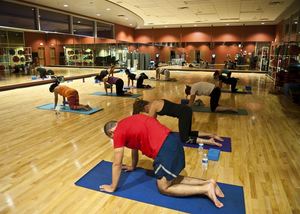
How to do:
- Find a chair to sit on.
- Hang on the edge
- Pull out either your left or right leg out in front of you
- Toes pointing to the ceiling
- Sit straight
- Roll your pelvis forward
- Feel a stretch
- Hold it for 30 seconds
- Release
- Switch legs
- Repeat
Exercise # 2. Wall hamstring stretch
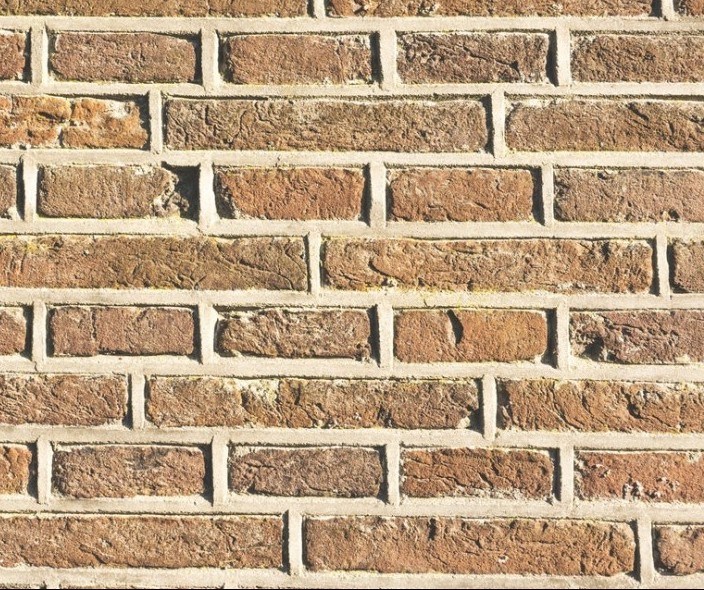
How to do:
- Lye on your back somewhere close to a wall
- Raise one of your legs up and against the wall
- Your other legs should be dropped down straight
- If you’re not comfortable, slightly bend your leg that’s on the bottom
- Try to be 90 degrees
- Feel the stretch
- Hold it for 30 seconds
- Switch legs
- Repeat
Exercise #3. Leg on chair
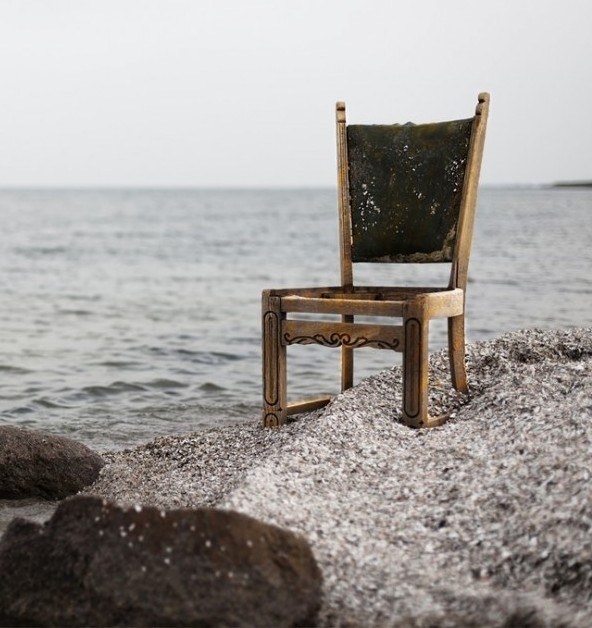
How to do:
- Place your right leg in top of a chair
- Bend your knee just slightly
- Lean forward with your upper body
- Try to touch your toes
- Hold it for 20 seconds
- Repeat for 3 times a day
Exercise #4. Prone hamstring Stretch

Tools:
- A towel, or a resistance band.
How to do:
- Find a flat surface to lay with your back to the ground. A mat preferably
- Extend both legs
- Grab your tool
- Raise one leg into the air, with your tool on the heel
- Your other leg is on the ground
- Aim for 90 degrees
- Pull back the tool towards you.
- Feel a stretch
- Hold it for 10 seconds
- Do it 5 times
- Switch legs
- Repeat
==>If you’d like to learn more about your hamstrings and more stretching you can go here<==
Then there are yoga stretches you should try. Such those are:
Exercise #1. Child’s pose
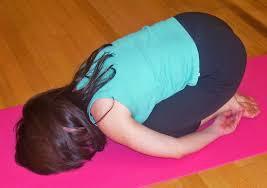
How to do:
- Find a flat surface
- Begin by being down on all four(hands and knees)
- stay calm on your breathing
- Release your thoughts
- Spread your knees wide apart
- Leave your big toes touching each other
- Relax your butt on the top of your heels
- Lay your hands on the floor behind your torso
- Head down between your arms
- Hold it for 1-3 minutes
Exercise #2. Front to back shoulder squeeze
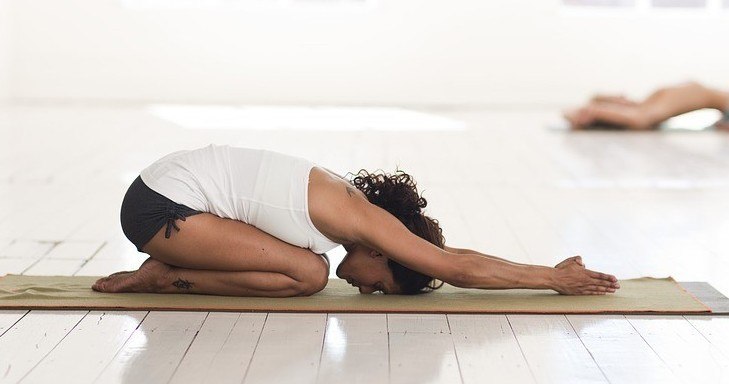
How to do:
- Find a surface. A mat works just fine
- Get down on all four, knees down
- Bend over, and place your forehead on the ground
- Place your arms and hands out in front of you
- Palms facing into each other
- Hold for 1- 3 minutes
Exercise #3. Clam
How to do:
- Lie on your side
- Bend your knees, and place your legs on top of each other
- Adjust your torso and hips so they are perpendicular to the floor
- Feet together
- Thighs together
- Contract your abdominal
- Keep feet together and raise your top leg up nice and slowly
- Come back down
- Repeat
Exercise #4. Glute Bridge
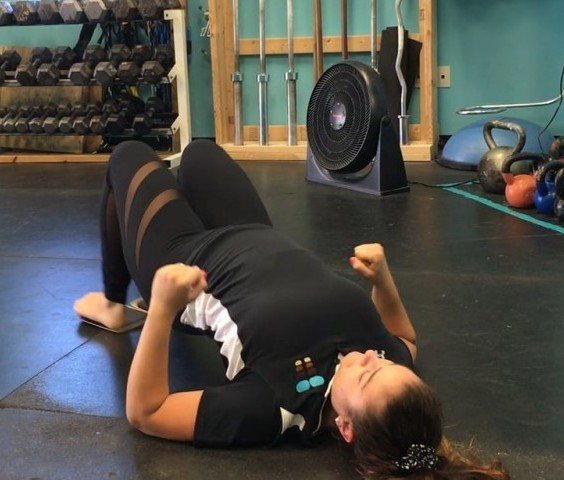
How to do:
- Find a flat surface to lay your back on
- Lift up your legs off the floor, knees up, feet flat
- Keep your hands out to the side or right next to you
- Slowly lift up your hips off the floor, and shoulders
- Squeeze your glutes hard
- Keep your abs in
- Hold the bridge position for a couple seconds
- Slowly come back down
==>To learn more about What yoga is, and which style is right for you, go here<=-=
This Will Work Best For You
Over the last 4 years, I’ve noticed my pain and inflammation significantly reducing because of several “key factors.”
I’ve been able to:
- Move freely
- Walk straight without struggling
- Prevent the chance of re-injury

Here’s what you can PROVE to gain for yourself…
- Herniated disc
You’re in luck! Luckily, you will be able to attempt exercises without going through surgery.
There are:
- A surplus amount of exercises
- Many claim to be the best for your herniated disc
I want to clear that up, and show you right now how to get from Point A to Point B, and from Point B to Point S- Success.
When a herniated disc affects your nerve, it will send pain signals down one side of your leg, and often to your foot(hernia). I want you to reduce your leg pain.
Here are your elemental steps:
Exercise # 1. Body Forward
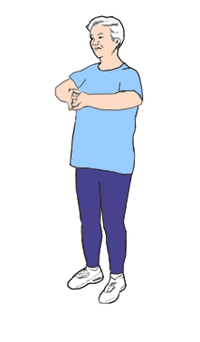
- Bring your hands over to the are you are in pain, and leave them there
- Place pressure on your back, causing you to move forward
- Bend backwards all the way you can
- let your neck follow back
- Hold it for 5 seconds
- Repeat 5 times
- Do it 3 times a day
The more your perform this exercise in your day, the sooner you’ll notice your leg pain reducing, and all your pain even disappearing!
Time. The best time to do it is when:
- You find yourself lifting
- bending forward and backwards
Now we want to get the pressure off the herniated disc. This is the most important thing. Treatment begins with taking off pressure.
Its time to target the smaller lower back muscles.
Exercise # 2: Pelvic Tilt

How to do:
- Find a surface to lay on your back
- Bend your knees
- Keep your hands to your sides
- Lift up your pelvis
- Hold it for 10-15 seconds
- Do it 10 times
- Do it for twice a day
It’s because of your weak muscles that there is unnecessary pressure on your disc. When you do this stretch it strengthens your muscle and allows your disc the room to breathe.
You’ll notice that you might get radiating pain down your leg. If this is the case, please stop and just do the other two exercises.
Exercise #3: Big Muscle Time

Goal: This stretch is designed to make your MUCH bigger lower back muscles MUCH stronger.
Targets:
- Your lower back muscles
How to do:
- Find a clear surface to lay on your stomach
- Move your arms out in front of you
- Place your hands under your head with your elbows bent
- Lift up both your arms and upper body
- Keep your legs and feet on the ground
- Repeat for a total of 10 times
- Do 2 times a say
Keep in mind: Your herniated disc can heal itself within 3 months. These exercises I just outlined will give you a speedier recovery. Write a goal down on paper or in your mind, and write down something like this:
“I will be cured, because I followed my exercises program”
What if you had a degenerative disc? “This is my cream of the crop”. Allow me to show you what its like to be free.
Exercise # 1. The Pelvic Tilt

Goal: Similar to when you have a herniated disc, the goal here is to take the pressure of your herniated disc, and strengthen your back muscles in the process.
Targets:
- lower abdominal muscles, for stability
How to do:
- Find a surface to lay on your back
- Bend your knees
- Keep your hands to your sides
- Lift up your pelvis
- Hold it for 10-15 seconds
- Do it 10 times
- Do it for twice a day
Exercise # 2: Bridges

Targets:
- Lower back
- Hamstrings
- Glutes
- Abdominal
How to do:
- Lay your back against the floor
- Keep your feet hip width apart
- Bring your arms and hands to the side of your body
- Inhale
- Raise up, one vertebrae at a time.
- Exhale at the very top
- Inhale back slowly on the way down, one vertebrae at a time
Exercise # 3. Hook-lying exercise

Targets:
- abdominal muscles
- strengthens lower back
How to do:
- Lay on your back on a flat surface
- Bend your knees and keep your feet flat
- Place your arms and hands by your side
- Contract your abdominal muscles
- Lift one leg, and have it come towards you
- Feel the stretch
- Hold it for 10 seconds
- Bring it back down
- Repeat 5 times
- Switch legs
- Repeat
- Do this twice a day
==>To learn how to treat your herniated disc naturally with more options, go here<==
Here’s more on how to exercise with a lower back pain:
3. Osteoarthritis
while it may seem counter-intuitive to exercise with osteoarthritis, with so much pain, It’s actually quite the opposite of this type of thinking…
its intuitive that you exercise because it will not only alleviate and finish your pain, but you will also cause the following:
- Doing flexibility and strengthening exercises will increase your range of motion, raise your elasticity in your cartilage, and reduce the stiffness in your joints that leads to pain.
- Then I’ll get you into low aerobic impact activities with a program to reduces the tension and stress on your joints.
- Controlling weight. By significantly implementing your exercise program, you’ll now be able to monitor your weight management.
- After, it’s necessary you keep in constant repetitive motions so your joints stay healthy
- We’ll increase the aerobic activity, and get that nice heart of your pumping, raising your heart rate, releasing those endorphins, therefore naturally numbing your pain
- Muscle strength. With muscle strength in you’ll be able to control the impact on your joints, since your muscles are like shock absorbers between the joints. This goes for the joints in your spine and around.
I understand how it can feel when your cartilage where’s down, and the inflammation begins. It’s the knock on the door you didn’t expect, especially from an uninvited guest!
Luckily, you can make an adjustment. I have to understand your range of motion to alleviate the pain properly.
And if your ready, I’m ready to offer you my wings for your full on board support.
Before You Exercise:
You need to open up your blood pathways to warm up your stiff muscles and joints, making it easier to go into a stretch. Using heat, by heat therapy will accomplish this.
After Your Exercise:
You’ve finished your workout, and now you have that all too common swelling around your body. Have you defined what is it?
If you said your joints, hey, you guessed right!
Ice therapy will lessen the inflammation from the swelling, and reduce the swells.
NSAIDs are another decent option, while I wouldn’t rely on using them long term. There are better solutions to it. But for the matter, Ibuprofen will work to alleviate your pain and inflammation.
Now that you know the not so secret tools, you can jump into these following exercises without reasons to cut yourself short.
Don’t run yourself to the ground with these exercises. A sufficient exercise/workout needs not extreme blood pumping range. Take your time, and roll with with the flow.
What About Water therapy?

If you haven’t been able to walk on land properly, could the water be better for your lower back?
In the water, that is your go partner. With osteoarthritis the pool is your ultimate friend. Here you’ll build enough resistance(waters resistance to flow) to build your strength. The surface tension and buoyancy of the water will ensure you get less impact to your joints, like you wouldn’t on land. You’ll strengthen quicker, when you increase aerobic activity. Learn how to swim the right way here.
Yoga. Yoga is my #1 go to right now, in the future and the past. What yoga does is strengthen and increase flexibility, especially range of motion. For your spine do this:
1. Cat-stretch pose

Targets:
increases blood circulation
How to do:
- Kneel on the ground. You can use a Mat for support if need be.
- Place your hands directly under your shoulders
- Keep your knees under your hips
- Inhale, and bring your back up, rounding it like a cat towards the ceiling. Keep your head up
- Come back down after 2 seconds
- repeat for 45 seconds to a minute
Here’s one for your hips anyone at any age can do:
2. Runners Lunge
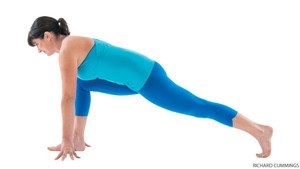
Targets:
range of motion, strengthens and relaxes your muscles, while re-aligning your joints. Most hip exercises are stand up.
How to do:
- Find a flight of stairs, ideally 5-8 steps will work
- Lean forward, and with your right hand, place it on the fourth floor
- Now, if you can do this, use your left hand to lift your left foot to the third floor
- Then place both hands on the upper floor(5th floor works best)
- Straighten your right leg and torso
- Tighten your right buttock, and move them in one straight line toward the stairs – bending your left knee until the right leg touches
- Lift your front hip bones up, which will increase the strength in your thigh muscles. If you feel a little burn, you’re on the road to success.
- Breathe and hold it for 15 seconds if you can
- Come back down in the sequence you moved up
- Switch legs and repeat
Guess what, there’s a variation of this!
LEVEL 2:

Tools:
- A couch
How to do:
- Position yourself so your right side of your body is next to the sofa
- Place your arms on the hand rest
- Now, bend your right knee, keeping your calf, and foot on the sofas seat
- Step with your left foot a couple inches( to stabilize)
- Push your hands against the armrest(apply little force), at the same time sliding your right knee back along the sofa- in a straight line
- Feel a good stretch in your right thigh. Breathe in and out
- Hold for 15 seconds
Note: Keep your hips forward, and your right leg as straight as possible. If need be, bring your left foot forward to keep a 90 degree angle in your leff leg.
To transition to your other leg, bend your right leg, sitting back on your right foot. Pull your left foot in, to stand up on it.
Change sofa ends to repeat for the other side.
There you have it. Building your joints is the ? (key).
Stronger joints = stronger muscles
=healthier well being.
==>If you would like to learn more about the best stretches before getting into yoga, see here<==
lets look at acute pain exercises now.
4. Acute Lower Back Pain
When you have a fresh injury, there are a couple stretches you should look at doing. When you have acute pain it is important to listen to your body as much as you can.
Exercise #1. Partial Crunches

Goal: To relieve the stress on your disc by strengthening your lower back and abdominal muscles.
Targets:
- Your Abdominal
- Your lower back muscles
How to do:
- Lay flat with your back on the ground
- Bend and bring in your knees
- Cross your arms over your chest
- Inhale
- Squeeze your stomach in
- Raise your shoulders off the ground
- Exhale as you raise up
- Hold for 5 seconds
- Repeat 8-12 times
Exercise #2. Bottom to heals stretch
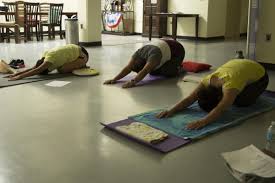
Goal: Bring stability to your lower back
Targets:
- Your tail bone
- Vertebrae
How to do:
- Kneel down on all four
- Keep your knees under your hips
- hands under your shoulder
- Try and have your neck and back straight
- Don’t lock in your elbows
- Exhale
- Slowly, move your bottom towards your heels
- Inhale in this position
- Hold it for 3 seconds
- Come back up
- Repeat for 8 to 10 times
The stretch makes a great yoga exercise.
==>Go here to learn about the type of yoga you should be doing for chronic lower back pain<==
Can I Get A combo #3?
When you go on to exercise, its always best when you can combine it with other activities such as:
- Walking
- Swimming
- Yoga
It’s best to start with one you feel the most comfortable then move from there.
- Walking
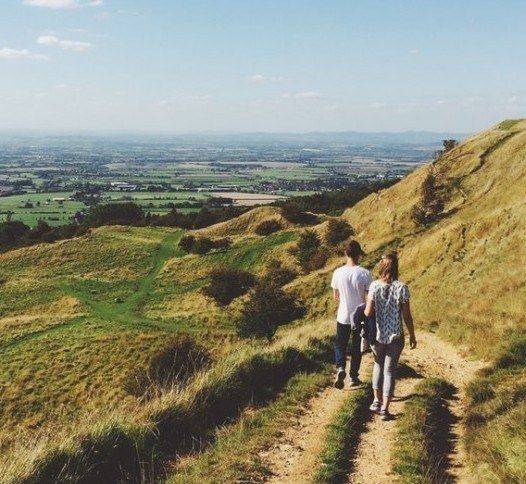
Walking provides:
- Bones and muscle strengthening
- Better nutrients to flow to your disc
- Mindless activity
==>Go see here how I’ve walked my way back to recovery<==

2. Swimming
Swimming provides:
- Less impact on your joints, less stress
- Your range of motion becomes greater
- Healthy blood flow to your large muscles
- Helps out smaller groups of muscles
==>Click here to find out how to cool off in the gentle water<==
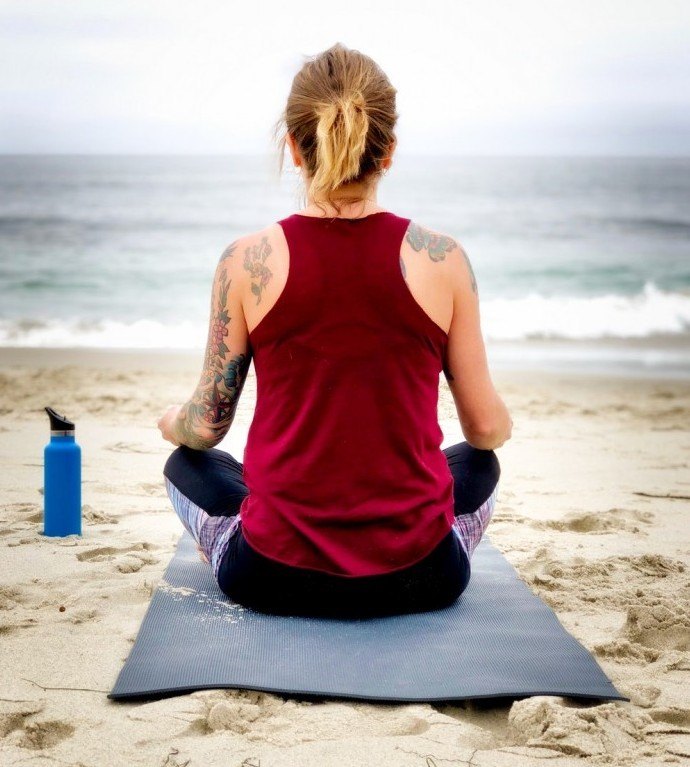
3. Yoga
Yoga provides:
- Better mobility
- Muscle, joint, tissue, ligament strengthening
- Flexibility
- Better mindset
- Mediation
Always follow your Physical therapist guide first. You can perform all three in your routine, or you can minimize is and start small. Either way you look at it, you will clear the horizon.
Exercise Your Way Into Freedom
The answers you seek have been laid out. These are free, no money down exercises you can do on your own time, and proven by me that these are the best, and will work.
Exercising provides you with SO much relief its crazy how one stretch can do so much god. You strengthen your muscles, cause nutrients to flow to your disc, get you posture back, and much more!
All of these workouts can be the right ones for you. They were made to minimize the impact on your lower back, and work around the spine and not through it. They are not intended to put any more hurt or disability to your back.
You can increase your routine by incorporating 3 other exercises in walking, swimming, and yoga.
If you have any questions, opinions, concerns, please do not hesitate to leave me a comment. I will get back to you before you know.
The Remove Back Pain System
Most of the time, back pain is caused by non-specific reasons(not related to your spine), and in this case, you should understand what it means to treat your joint pain, and what exercises can help.
Continue with the Remove Back Pain System by learning about the treating a joint pain here.

It’s so funny I ran across your post. I actually hyperextended my knee a few weeks back and it’s much, much better but not yet 100{b2e0dba9c93837a4f3ce441fa43dc3a0e947a29fe0fd2c517ea2237d7754a6d7}. I was so frustrated because I’d just gotten into a new exercise routine and was pushing myself hard..which is how the injury occurred. I’ve been doing several of the exercises that you mentioned above as well as incorporating many more yoga poses into my routine. I also have lower back issues due to my job so I try and make a habit of doing some child poses and stretches and I’ve been working on strengthening my core and back as well. Thank you for the great info and the new ideas you’ve given me for my gym routine!
Good timing 🙂 oh really? I know that feeling…You create a fast pace, hard working routine and snap, things can change in a matter of seconds. I’m happy you’re using these exercises. They are all great for beginners to more advanced. Yes, Yoga! It’s my go to. At work there are great stretches to do, ranging from being at your desk chair to standing up. You are welcome!
I really like how you explain what to be doing by bullet point on how to do these exercises. Not too many people go the extra mile to make sure everyone who reads their info “knows” how to do what they are explaining. Keep up the great work and thanks for the read
Hi Aj,
Thank you. I believe in being as specific as I need to be because I wouldn’t want someone who is new to a stretch to cause them selves more damage or someone who already knows hasn’t seen a different variation. You’re welcome.
Hi Michael.
That’s a great post with some fantastic information, and really good explanations. Important to doing the exercises correctly. Thank you for that.
I have dealt with a lot of back pain in the past. But fortunately, I am doing a lot better know. A big part of the reason for that is a lot of the exercises you mention here. Specifically yoga, squatting, walking and swimming are thing that have had a HUGE impact on my back health. I’ll definitely look into some of the other exercises you mention.
Thank you so much for a great post! 🙂
Cheers,
Michael
Hi Michael,
I feel and know it’s important to get the most out of exercising. It’s the #1 treatment. Unfortunetly, for some people it’s not easy to maintain once they do get there, and lose track. There’s no other way to treat the actual root of the cause besides going at it dead on. But luckily there’s ways to get people to consistently do it, that’s why I’m here to help. I’m happy to hear! You’ve headed in the right direction, and you will you continue to do so. Keep consistently at it. I’ve made another page full of lower back exercises with sciatica too, if that interests you. Thank you! And feel free to look around:
https://removebackpain.com/xercises-for-lower-back-pain-and-sciatica-only-going-up-from-here/